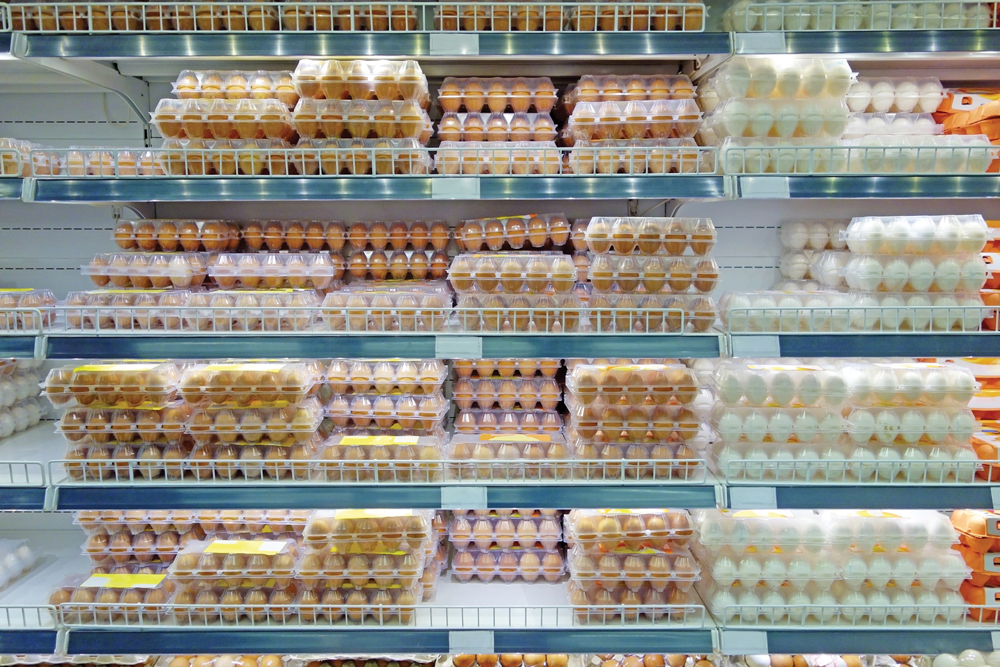Not all costs are counted yet, but Manitoba’s supply-managed producers appear to be emerging from the pandemic in better shape than their beef and hog farming counterparts thanks, in part, to their ability to co-ordinate supply collectively.
“(Supply-managed producers are) facing similar issues — they’ve dumped milk and eggs in a similar way to hog producers who may have to cull a bunch of pigs,” said Ryan Cardwell, a researcher and professor of agriculture and food policy at the University of Manitoba.
“One of the big differences, though, is that the losses incurred in doing that are shared out evenly across producers,” Cardwell said.

“Because of our organization, we can do things together right across the country,” said Harold Froese, board chair of Manitoba Egg Farmers.
In the early days of the pandemic, retail sales of carton eggs spiked while demand for eggs in the food industry dried up, said Froese. Retail demand has since levelled off, and while restaurant demand is climbing as the economy reopens, it’s not increasing quickly said Froese.
“We don’t know how much of that sector is not going to come back,” Froese said.
Because of decreased demand, some farmers were asked to take their flocks out of production early to reduce the number of eggs going to market, Froese said. As a group, eggs farmers then compensated those individuals for their losses.
Read Also

Mazergroup’s Bob Mazer dies
Mazergroup’s Bob Mazer, who helped grow his family’s company into a string of farm equipment dealerships and the main dealer for New Holland machinery in Saskatchewan and Manitoba, died July 6 from cancer.
“That is probably the biggest benefit that we have,” said Froese.
Manitoba Egg Farmers also donated excess eggs to Winnipeg Harvest.
He added that while it’s not yet clear what toll the decrease in demand will have on egg farmers, “so far, we’re not too badly off.”
Dairy farmers also had a co-ordinated response to the drop in demand.
“We very quickly reduced production over a period of two or three weeks, and it was not a matter of shutting off certain farmers,” said David Wiens, chair of the Dairy Farmers of Manitoba.
“The pain was spread across all farmers in Canada, and of course that reduced the pain on each farm,” he said.
In Manitoba, DFM didn’t reduce quota but restricted certain flexibilities in the system that formerly allowed farmers to sometimes produce above quota. DFM also donated 120,000 litres of surplus milk, in the form of cheese, to Winnipeg Harvest.
Worldwide demand for milk proteins dropped, said Wiens. This had a “little bit of a dampening effect” on blend prices farmers received. This, combined with decreased production and compensating producers for dumped milk, added financial pressure.
This in contrast to the United States, where Market Watch reported that the price for Class 3 milk (which is used to make most cheeses) dropped to its lowest price since September 2009 in mid-April at $12.11 per cwt.
U.S. dairy farmers are not supply managed.
However, if supply-managed producers are doing better, it can’t entirely be attributed to supply management. Dairy, egg and chicken processors didn’t see the massive shutdowns that the beef and pork processors did.
“Our production hummed right along. We had no disruptions. Our processing hummed right along,” said Wayne Hiltz, executive director of Manitoba Chicken Producers. “Our processors, they really stepped up (safety procedures) quickly when COVID was breaking back in March.”
Chicken producers did have to cut production. Recent allocations have been regional, said Hiltz, as the East has been harder hit by COVID-19 losses than the West. Farmers reduced production in Western Canada by just over six per cent for July and August, said Hiltz. In the East, production was reduced by just over 11 per cent for the same period.
In hindsight, said Hiltz, production decreases in Manitoba were probably a bit too aggressive as things have opened up faster than expected. Nevertheless, the eggs are set and that die is cast.
Hiltz said most further processing of chicken (e.g. frozen, breaded product) is processed in Ontario and Quebec. As restaurant demand for these products dried up, this contributed to production loss in the East.
Chicken Farmers of Canada said production had been reduced by just under 13 per cent for May and June in a May 5 news release.
In that release, the organization asked the federal government for a commitment to cover costs if producers were forced to euthanize flocks for reasons related to COVID-19. No flocks had been euthanized to date, the release said.
“We’re not looking for compensation for our reduced production,” says Benoît Fontaine, chair of Chicken Farmers of Canada. “We’ll take care of this ourselves.”
But with chicken farmers, as with other supply-managed commodities, it isn’t entirely true that they take care of themselves. While their losses aren’t subsidized by the government, supply-managed farmers are effectively subsidized by consumers, said Cardwell.
“You benefit from prices that are substantially higher than they would be without government policies to keep them so high,” he said.
Normally, if a market is flooded by product (e.g. too much milk), this would drive prices down, however, “(supply-managed producers are) in the unique position of having the legal authority to restrict industry output (and therefore control prices) through cartelized production and marketing,” Cardwell said.
In other words, if demand for a product drops, instead of reducing prices to increase demand, the marketing boards can use their authority to reduce production or dump product to keep the price high.
“That’s unusual. Most industries don’t operate that way because in other industries doing that is illegal,” said Cardwell.
This is not to say that milk would have been sold, not dumped, if not for supply management. “There was milk being dumped in the United States,” added Cardwell.
Processing was a bottleneck for milk, eggs and other foods as demand shifted from food service to retail, said Cardwell.
“There were real logistical issues here – fresh milk has to be dealt with quickly – processed or dumped. It takes time to reconfigure supply chains from food service to grocery stores,” he said.




















